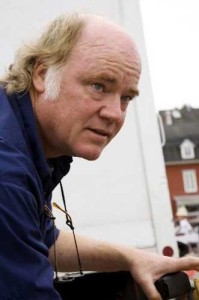
Following in the footsteps of Willis O’Brien on King Kong and Ray Harryhausen on numerous films thereafter, including Mighty Joe Young, The Seventh Voyage of Sinbad and Jason and the Argonauts, Phil Tippett created the stop-motion character animation in films ranging from Star Wars to Dragonslayer to Robocop. But it was a 1993 film which changed his career from that of a hands-on puppet animator to a supervisor of computer graphics animation. In this exclusive interview, he recalls his transformation on that landmark film and reflects upon how the work holds up today.
Below the Line: What was your first entry into Jurassic Park and how did your role evolve?
Phil Tippett: The first call I got was from producer Kathy Kennedy right after I finished Robocop 2 in 1989. They said they had this big dinosaur project. At that time she didn’t tell me it was Jurassic Park. Steven (Spielberg) was involved and they were going to do a full-scale robotic thing. I didn’t see that as feasible. She called back a year and a half later. She sent me the very secret galleys before it was published. They put together a deal at Universal. I went down and they hired me because I knew a lot about paleontology. I had made some short documentaries with dinosaurs. I was in the right place at the right time. I knew why they were doing what they were doing.
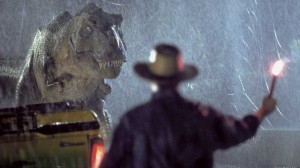 BTL: What were some of your first tasks on the project?
BTL: What were some of your first tasks on the project?
Tippett: In the early stages, I became involved when they were putting together the script with David Koepp. On the page, it works for dramatic purposes. He had a brontosaurus for the opening and I suggested a brachiosaur. I advised on that level. John Bell did a lot of storyboards, and Steven and Kathy wanted to have animatics made for the tyrannosaur paddock and the raptor kitchen scene. I put a team of people together and did stop-motion animatics. We started with the dinosaur bible, doing stop-motion walk cycles and pantomime of what these characters would do: an 800-pound raptor and a three-ton tyrannosaur. That was used for continuity between Stan Winston and what became the ILM [computer-generated dinosaur characters].
BTL: Was there a period when you were going to actually produce go-motion for the finished film?
 Tippett: Yes, I had jobbed out to various vendors. There was a period of eight-to-nine months – just enough to get it in progress. “Let’s do it with full-scale props and do go-motion.” Dennis Muren wanted to push the computer graphics furthers. For the gallimimus stampede, when they were doing their tests, they found out that they went beyond their expectations. Steven wanted to make the movie that way. When we presented the first tyrannosaurus CG test, Steven asked what I thought and I told him I felt extinct.
Tippett: Yes, I had jobbed out to various vendors. There was a period of eight-to-nine months – just enough to get it in progress. “Let’s do it with full-scale props and do go-motion.” Dennis Muren wanted to push the computer graphics furthers. For the gallimimus stampede, when they were doing their tests, they found out that they went beyond their expectations. Steven wanted to make the movie that way. When we presented the first tyrannosaurus CG test, Steven asked what I thought and I told him I felt extinct.
BTL: Were you surprised by the advancements in computer-generated imagery at that time?
Tippett: I was not shocked. I’m good friends with Dennis Muren. We were going to partner on it between my studio and ILM. I was not surprised when Steven had the edict to do it that way. At the same time, it was emotionally the end of my world. Jurassic Park had finally done it. I had supervised Robocop and Honey, I Shrunk the Kids, [so] I knew how to put the stuff together.
BTL: What were the key initial challenges of using the computer for animation on the film?
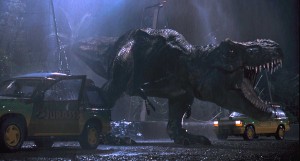 Tippett: The computer graphics guys didn’t know anything about filmmaking. The state of the technology at the time – there weren’t that many computer graphics animators. They did traditionally cartoony Disney animation. When you have to fit a character that weighs three tons, into a real background, that’s a total different can of worms.
Tippett: The computer graphics guys didn’t know anything about filmmaking. The state of the technology at the time – there weren’t that many computer graphics animators. They did traditionally cartoony Disney animation. When you have to fit a character that weighs three tons, into a real background, that’s a total different can of worms.
BTL: What did being dinosaur supervisor entail for you at the beginning of that process?
Tippett: Steven and Kathy let me work with sound designer Gary Rydstrom for a week. It would help everybody a lot if we can nail the voices before we can do the animation. Very much like for an animated feature – if you have the voice, you know more about the character. Gary built up the voice for the tyrannosaur and the raptors.
BTL: How did you liaison with ILM when animation developed?
Tippett: The Dinosaur Input Device allowed the stop-motion animators at my studio to animate the tyrannosaur and raptors and then send that to ILM. The DID was essentially a stop-motion armature hooked up to these sensors and a spaghetti wire tail that went into the computer which drove a wire-frame version in the computer. We were using Softimage at that time – the animation package that was developed. It gave us all of these parallel lines that show how this character performs. There is a tendency to make that aesthetically pleasing.
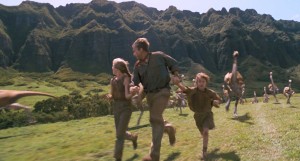 BTL: At what point were you present on set during principal photography?
BTL: At what point were you present on set during principal photography?
Tippett: I was there for all the parts that would ultimately have a computer-graphics dinosaur. We weren’t needed for the triceratops or the spitter. I was on the set every day with Dennis. We had all of the animatics together. We used that as a production tool: here’s the scene, here’s the shot and let’s find that. At that point in time, the way movies were made is very different from how they are made now. The amount of planning and execution is much more focused than it is now. Everyone had a clear idea of precisely what we were doing.
BTL: Would you advise the other members of the production team during shooting?
Tippett: I went down to the set in Kauai or at Warner Bros. or Universal, making sure that everything we’d planned with Stan Winston would function. We did a lot of work with Michael Lantieri who did the rigging. If the brachiosaurus pulled leaves off of a tree or a raptor was running, it had to be very tightly choreographed and planned ahead of time.
BTL: Did you also work with the actors for scenes that would eventually have dinosaurs?
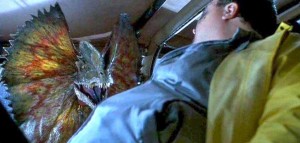 Tippett: A trained actor is able to react to something on the page. It galvanizes the whole crew. Depending upon what animal is up, you need to have some kind of displacement so that you can get eyelines for your actors. We had big paper cutouts. Traditionally Ray Harryhausen and Willis O’Brien used monster sticks to indicate the height and length of the creature. You set that up relative to the camera and build the shot around that. You do takes until the actors get the eyelines right. Steven was shooting very fast. There were not a whole lot of takes. There were complicated setups that had eight or nine takes. Steven said at the beginning he wanted to shoot like Clint Eastwood because of the budget.
Tippett: A trained actor is able to react to something on the page. It galvanizes the whole crew. Depending upon what animal is up, you need to have some kind of displacement so that you can get eyelines for your actors. We had big paper cutouts. Traditionally Ray Harryhausen and Willis O’Brien used monster sticks to indicate the height and length of the creature. You set that up relative to the camera and build the shot around that. You do takes until the actors get the eyelines right. Steven was shooting very fast. There were not a whole lot of takes. There were complicated setups that had eight or nine takes. Steven said at the beginning he wanted to shoot like Clint Eastwood because of the budget.
BTL: Once you made it to postproduction, how were your daily duties comprised?
Tippett: The typical day would be to setup a broadcasting network and have dailies together – my guys at my studio would beam in Dennis at ILM and give suggestions for adjustments in the shots. After dailies, I would spend the morning with my guys and lay out the details for the tyrannosaur and raptor. In the afternoon, I would go to ILM. The one thing is that the computer is an editorial device – build and build and edit and edit.
BTL: Did you have any inkling that you were breaking ground with this type of realism with these characters?
Tippett: You never know what you were going to end up with, but the confidence level was very high. At the end, we set a new high water mark. Dennis and I went to Amblin and Kathy ran the first answer print. I thought, “It’s not terrible.” There was a tremendous amount of relief once you see it.
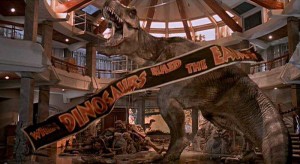 BTL: Once you finished Jurassic Park, you pretty soon went to Starship Troopers, which took the animation ideas in Jurassic Park to the next level. Was the experience of supervising animation on those films similar for you?
BTL: Once you finished Jurassic Park, you pretty soon went to Starship Troopers, which took the animation ideas in Jurassic Park to the next level. Was the experience of supervising animation on those films similar for you?
Tippett: Troopers and Jurassic Park were made not that far apart and are totally different animals than what are done today. [Director Paul] Verhoeven and Spielberg were very much about planning. On Troopers, there were a lot more moving parts. We would shoot for six days and on the seventh day, me and [editor] Mark Goldblatt would assemble it. We would show it to Paul and it worked. Now, there is a lot of non-planning and a lot of fixing.
BTL: How do you feel about Jurassic Park now, 20 years onward?
Tippett: I think Jurassic is better than most stuff being done today. The production approaches – everything is a lot speedier. And we don’t have directors of the caliber of Verhoeven and Spielberg. I was really lucky to be alive back when they made good movies.
BTL: There is an 80th anniversary going on now for the original King Kong. Do you feel as though that film had a similar impact to Jurassic Park in its time?
Tippett: As a kid, that was what I cut my teeth on. I saw it in 1955 on TV when I was five years old. From that moment, my eyes bugged out of my head. When I was a teenager, I got a 16mm print and ran it until it shredded. There is a magic that goes beyond reality. Your suspension of disbelief is complete. There is an artistry to how the big glass shots are put together. You are working with a real thing with real light on it. It looks real by that virtue. In Peter Jackson’s King Kong, they had a lowland gorilla as a model for their performance, like the Life of Pi tiger, observing animal behavior and translating that into computer graphics. King Kong was more real.





